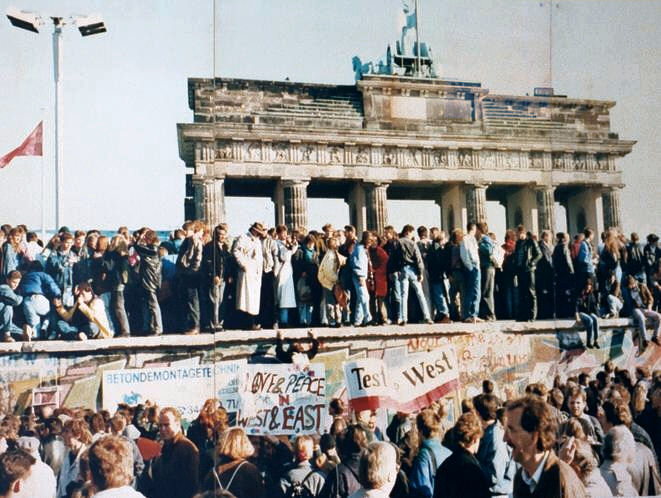
(Picture released by the Senate of Berlin)
By Hassan Humeida
KIEL, GERMANY: German unity was enshrined in history as a peaceful turning point in 1990 following the fall of the Berlin Wall. At the heart of this process Helmut Kohl stood as the central chancellor of unification, decisively driving the process forward through determined negotiations and landmark treaties.
In 1990 and 1991, intensive talks on monetary, economic, and social union paved the way for the integration of East and West Germany. The accession of the new federal states to the Federal Republic consolidated the democratic order and enshrined the rule of law across the reunited nation.
Reunification ushered in a comprehensive phase of a far-reaching transformation from a centrally-planned economy to a market-based economy. Major investments in infrastructure and regional development placed special emphasis on revitalizing eastern Germany, fostering growth and social cohesion.
Thirty-five years after reunification, Germany stands as a symbol of economic stability and social modernization. It has become one of Europe’s leading export nations, driven by innovation, small and medium-sized enterprises, and a forward-looking digital transformation. Germany’s unique model combines the strengths of a social market economy with sustainable investments, making it both competitive and socially balanced.
As a model country and a central actor in the European Union, Germany embodies the principles of the rule of law and the welfare state. It is a staunch advocate of multilateral cooperation, peacekeeping, and humanitarian aid initiatives worldwide. The German economic system combines a social market economy with sustainable investments.
Its global commitments include climate protection, energy efficiency, and the expansion of renewable energy, positioning Germany as a flagship nation in the fight against climate change. Within Europe, it acts as a stabilizing force, promoting integration while driving economic and political progress.
Germany remains a model for global leadership in trade and climate and strives to uphold democratic values, sustainable development. Its trajectory since reunification illustrates how reconciliation and transformation can lead to both prosperity and stability.
The German reunification was the result of complex processes, not a single decision. The German people made the primary contribution to this process. In addition to Helmut Kohl and the German government, other individuals played a historic role in German reunification. Three important figures stand out:
Chancellor Willy Brandt played a central role in Ostpolitik (Eastern Policy), which laid the foundations for later German reunification. His policy of rapprochement with the GDR, Poland, and the Soviet Union reduced tensions and opened channels of political and economic exchange. The Basic Treaty with the GDR (1972) was an important step, establishing recognition of the existence of the GDR and establishing constitutional foundations for cooperation.
Brandt’s approach helped to link East and West Germany economically, politically, and culturally and to reduce long-standing tensions. Actual unification took place in 1990, but Brandt’s actions enabled the changes that helped pave the way for peaceful reunification.
Chancellor Willy Brandt’s historic statement, “Now what belongs together can grow together,” went viral at the time. It was a shortened version of his Ostpolitik (Eastern Policy) concept for reconciliation and peace in Europe, “Change through Rapprochement,” which he used in various speeches.
Hans-Dietrich Genscher, the Foreign Minister and Vice Chancellor at the time, played a central role in the foreign policy of German reunification, particularly through diplomatic initiatives such as the speech on August 31, 1989, and his efforts in talks with other states. He was a key player in the implementation of German reunification.
Gregor Gysi played a central role in the transformation of the East German SED into today’s Left Party after reunification. He was a leading figure in the SED/PDS, oversaw the transformation of the SED into the SED-PDS/The Left, and advocated for a new political identity.
As leader of the PDS parliamentary group in the Bundestag, he shaped the party’s public relations work and political orientation in parliament. He became a symbol of renewal and the adoption of basic democratic values, while the party developed into a left-wing alternative in German politics.
The German reunification, in its 35th year, should prove that the reunification of a divided people in two parts is possible. It requires courage, willpower, clever minds, and intensive and continuous work among the people on both sides. Successful, selfless policies pave the way for reunification. Korea as a nation can follow this path, following the footsteps of a united Germany, and chart a roadmap for a strong, unified Korean peninsula for the divided people, both present and future generations. These interviews are intended to encourage the Korean people and politicians there to take this important step, so that reunification after 80 years of separation does not lose sight of the goal. After all, Korea, Asia, and the global world need a stable, strong, and peaceful Korean peninsula.
The German reunification, in its 35th year, should prove that the reunification of a divided people in two parts is possible. It requires courage, willpower, clever minds, and intensive and continuous work among the people on both sides. Successful, selfless policies pave the way for reunification.
Korea as a nation can follow this path, following the footsteps of a united Germany, and chart a roadmap for a strong, unified Korean peninsula for the divided people, both present and future generations.
To mark thirty-five years since this historic achievement, AsiaN has conducted a series of interviews with people across Germany, voices from East and West, rural areas and major cities. They shared personal experiences, hopes, and challenges, and reflected on common questions about the future, reflecting candidly on how reunification shaped their lives and impacted influenced their perspectives.
In this interview format, AsiaN aims to provide genuine insights into their lives, social developments, economic changes, and political perspectives.
These conversations go beyond politics and economics: they shed light on social developments, individual aspirations, and the evolving identity of a united Germany.
The interviews are also intended to encourage the Korean people and politicians there to take this important step, so that reunification after 80 years of separation does not lose sight of the goal. After all, Korea, Asia, and the global world need a stable, strong, and peaceful Korean peninsula.
The interviews will be published this week.
AsiaN is deeply grateful to all those whose words embody dignity, and hope, and who opened a window into the heart of humanity, expressing genuine feelings, and offering sound advice on how lessons from Germany’s remarkable journey may inspire and guide reunifications, especially in the Korean Peninsula.
Hassan Humeida is an Honorary Member at the Asian Journalists Association (AJA) and Journalist at The Asia-N Magazine – Seoul, South Korea. He lives and works in Kiel, Germany.
Email: hassan_humeida@yahoo.de




